President's Message
Fellow woodworkers,
I recently read an old copy of Home Furniture dated November 1997. There was an article called "San Francisco, Where Furniture meets the Microchip"
It talked about the Bay Area breeding a new kind of furniture maker: "young American furniture designers make their mark…..in the scrappy warehouse districts along San Francisco Bay" "blending an artisan sensibility with the start-up mentality of Silicon Valley."
"Milan by the Bay": these "Hip" designers were copying the model being used in Milan where young, independent, designers were creating the designs for the large furniture-making companies. A business style that was not used by the US furniture companies at the time.
The woodworkers mentioned in the article included:
Andy Hope of Co-Motion, 960 Howard Street.
Andy was a computer designer who moved in to furniture design. He shared his space at 960 Howard Street with software design engineers. One of his designs was a CD table made in plywood and steel. The building still exists but it is now a Fitness center.
Eric Pfeiffer of Bravo 20, 161 Natoma Street.
One of his designs was perforated stacking boxes designed "for people on the move" They were exhibited in the San Francisco Museum of Modern Art which was close to his workshop. The building has been given a facelift and is now occupied by a men's clothing store.
Christopher Deam CCD, 47 Lusk Alley.
Christopher's designs included a plywood and stainless cabinet. 47 Lusk Alley has now been joined with 36 Clyde Alley and is available as office space. Incidentally next door at 25 Lusk is one of San Francisco's in bars. An alley no one would have even dreamed of walking down after dark just 10 years ago.
Ted Boerner Studio G, 10 Arkansas Street
Ted's line of designs included blond wooden chairs with clean curves.
He is quoted in the article as saying: "there is a real community of woodworkers here.. it is easy to get 40-50 people together for a meeting. Ted Boemer Furniture is still there but it is now a showroom not a workshop. The company, Ted Boerner New York, has several showrooms across the country.
Derek Dorrestyn, founder of Module, 1450 Bancroft Avenue.
The manufacturing building looks as if it has been recently renovated and available for lease. The word module is used a lot in furniture these days but I do not think Module, the furniture design company from Bancroft Avenue is still in existence.
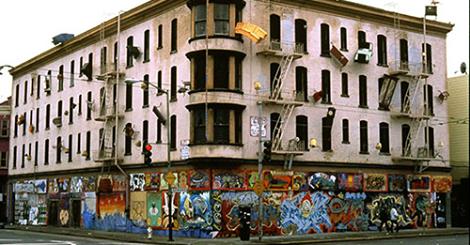
An artwork called "Defenestration Building"
by Brian Goggin
About this time furniture became the main attraction on the old Hotel Hugo in San Francisco – not my taste but it did last until last year when they started to demolish the hotel. But at least furniture became something people had to look at.
Since 1997 there have been big changes and I think most of these woodworking organizations closed or left San Francisco but in recent years many other woodworking companies have surfaced. The group of woodworkers at Alameda Point and the many woodworkers from around the area who have visited us at BAWA including Chris Weiss, Roger Heitzman, Scott Wynn, Jarad Rusten, Lou Kern, Loy Martin plus several of our current BAWA members who are active professional woodworkers.
Unfortunately some things have not changed; owners can generally get a much better return on their properties if they lease them to new-style businesses than if they lease them to woodworkers. I know of a small woodwork operation that who, along with a number of artists, subleased space in a building in the San Francisco. The building has recently transferred to new owners and the artisans are going to have to move out. The building has a lot more earning potential than a few artisans can provide.
Enjoy your woodworking.
Frank (Contact at: Frankramsay8@aol.com)
President Frank Ramsay called the meeting to order at 7PM.
New Members and Guests:
Guests were announced as follows:
Scott Davis, a woodturner, Steve, Dennis, Bob and Jim.
Announcements:
Per Madsen then talked about the upcoming Calendar events.
March 19th there will be a presentation on Hide Glue by Neal White and Harold Patterson.
April 16th we will have a talk from John Lavine.
May 21, a talk by Jennifer Alger from Far West Wood Products on urban forestry.
June 18 a talk by Alan Olson on the educational Tall Ship Building Project followed by a later weekend tour of the site.
July 16,a talk by Ron Ashby on shellac.
September 17,a talk by Dean Santner of Alameda Point Studios.
We still need speakers for August, September and October and Per is always interested in your suggestions.
Steve asked for a show of interest in members who would like to hear about opportunities to harvest urban lumber as we get about one request a month from people interested in having downed trees removed. Ken Napior evinced interest.
Harold Patterson reported that some toys from the Christmas Toy Workshop were donated to the Emmet Pass Elves who sent us a letter of thanks.
Dan Goodman described the upcoming Rebuilding Together project, which will take place on Saturday April 25 at a single family home in San Bruno. It will involve rebuilding a fence and a deck. It will also involve a prep day in advance of the main action on April 18. Dan passed around a sign-up list.
Yeung Chan
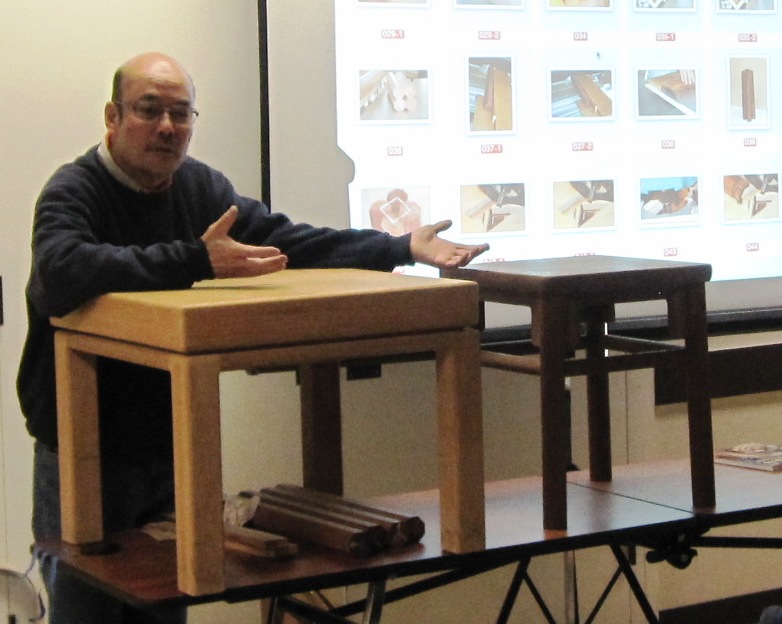
Per then introduced the main speaker, Yeung Chan, a club member who is an expert on Chinese traditional furniture construction and design.
He brought in two Ming dynasty style table reproductions that he has built and talked extensively about the techniques and fixtures required to build one of them. The modern version can be built using on a table saw, router, and drill press, whereas the traditional one has more complex joinery and requires many hand tools as well. The modern one is made of walnut with an oak exterior. The frame is alder joined with dowels. The top consists of 4 pieces of white oak mitered together with biscuits. Yeung described the construction of the traditional version in detail. He used this table as a project in a 5-day class he gave and most students were able to complete it in that time.
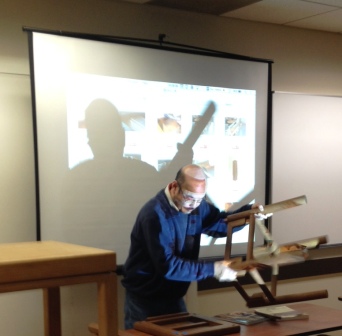
It is made of Malaysian kwila wood. The round legs are set at a 2-degree angle joined to the top with tenons. The tabletop is a thin square piece made of lumber joined together edgewise. There is a tapered sliding dovetail underneath it to provide support. The tenons were made with a special fixture set at a 45-degree angle on a sled, The mortises were cut using a router and then cut off at 45 degrees on the table saw. After the tabletop was joined together with miter joints, the rabbet was cut into it to receive the tabletop. The top consists of 3-4 pieces, 3/8 inch thick joined together with tongue and groove joinery.
To make the legs and rails he starts with 2 inch thick stock and cut off the 4 corners using a jig on the table saw to give a piece with an octagonal shape. He then used a 2-degree wedge to cut off the top and bottom of each leg at the proper angle. The leg tenons were stub tenons set at 90 degrees to each other and designed so that they did not impinge on the joinery of the aprons. Yeung had to design a special router fixture to locate the tenons properly, which guided a top bearing router bit. He milled the slots in the legs and the mortises for the leg tenons using a mortising machine. After completing the joinery making use of the references of the leg sides to get the joinery accurate, he rounded the legs using a block plane and a template. He also showed a fixture for mounting a router on a box in which the piece to be rounded is mounted below the router and turned on a shaft to achieve the same purpose. This would be useful if there were a large number of pieces to be rounded and one did not have a lathe.
A bird's mouth is then cut on the band saw using the 2-degree wedge. One needs to practice before doing this cut to get the proper hand eye coordination. The final step is to cut the grooves with a slot cutter.
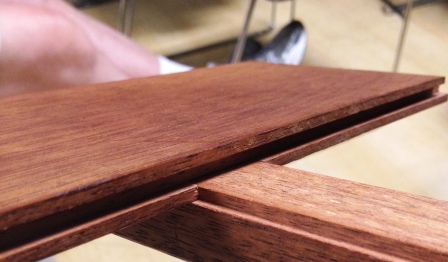
Sliding dovetail holding top panels
The apparent simplicity of the final product belied the complicated and skillful work need to achieve the end result.
Yeung then gave a short talk with photos on his visits to China where he engaged hobbyist woodworkers who had had no training in woodworking but wanted to learn. Yeung set up a workshop on tool sharpening which amazed them with the edges he was able to achieve on a knife, a chisel, and a hand plane. He showed them how to adjust the blade on metal and wooden hand planes. He also encouraged them to buy a Sawstop table saw so they could do more ambitious projects and gave them a one-day class on how to use it.
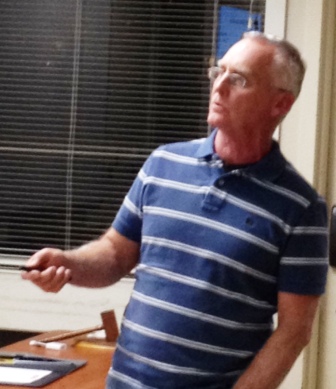

Ken Napior spoke about Queen Anne reproduction furniture. He referred to a book by Norman Vandal entitled "Queen Anne Furniture". The original furniture was built from 1720-1760 and has clean fluid lines with few frills. He suggested the book "Furniture Moldings" by E.J. Warne to get ideas about the proper moldings to use. The doors and drawers all have rounded edges and the fronts have cock beading and ogee curves and the design uses cabriole legs. Fluted columns are sometimes used which can be formed either with a router or with carving tools. Lastly, you should always use appropriate brass hardware.
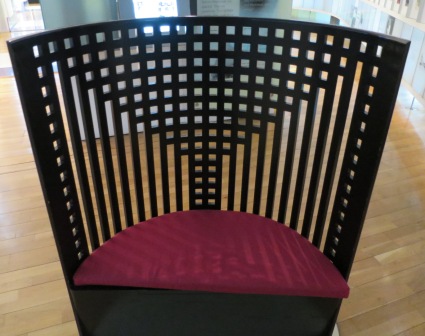
Arnie Champagne then talked about a back-stretching device, which he designed, and built using laminated hardwood on a specially designed form. It has proved very useful with Arnie's spinal problems and the VA Hospital is interested in obtaining 20 of them to use in its rehab program so Arnie is looking for ways to make the construction quicker and simpler.
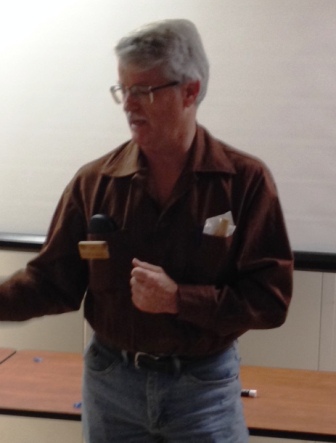
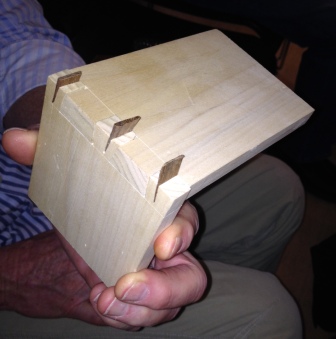
Neil White showed a example of a wedged dovetail joint he saw at Williamsburg.
The meeting adjourned at 9:25 PM.
Steve RosenblumSecretary steve@rosenblums.us
